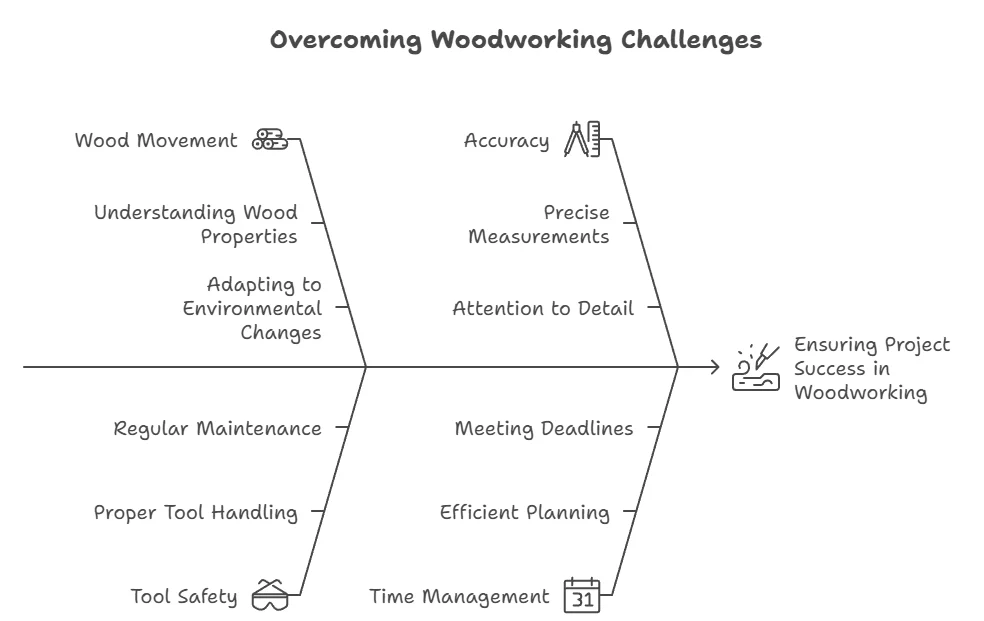
Woodworking can be an incredibly rewarding hobby, especially if you’re a beginner looking to create something functional and beautiful for your home. There are many creative Furniture Woodworking Projects that anyone can try. These projects not only help you develop your skills but also add a personal touch to your living space.
Beginner-Friendly Woodworking Projects
If you’re just starting, consider taking on beginner-friendly projects. Simple Furniture Woodworking Projects can help you build skills and confidence. Here’s a brief list:
- Bookshelves
- Storage boxes
- Simple tables or benches
- Wooden toys
As you gain experience, you can move on to more complex Furniture Woodworking Projects, such as chairs and cabinets.
By investing in the right tools and taking the time to learn, you’ll be well on your way to creating beautiful woodworking masterpieces.
1. Simple Bookshelf
A bookshelf is one of the simplest Furniture Woodworking Projects you can start with. It allows you to learn basic skills like measuring, cutting, and assembling wooden pieces. To make a simple bookshelf:
- Gather materials: plywood or lumber, screws, and finish of your choice.
- Measure the space where you want to place the bookshelf.
- Cut the wood to the desired dimensions.
- Assemble the pieces using screws, ensuring everything is level.
- Sand the surfaces and finish with paint or varnish.
For detailed instructions, check out Wood Magazine.
2. Decorative Side Table
A decorative side table is another fantastic project that offers a blend of aesthetics and utility. You can customize its size and shape to fit any corner of your home.
To create a side table:
- Select your favorite wood type for the top and legs.
- Cut the tabletop into a round or rectangular shape.
- Cut the legs and attach them securely to the tabletop.
- Consider adding a shelf or drawer for added functionality.
- Finish with your desired stain or paint.
This project not only enhances your woodworking skills but also helps you make a statement piece for your room.
3. Wooden Stools
Building a set of wooden stools can be a fun and easy project. They’re great for additional seating and can be made in various styles.
Here’s what you need to do:
- Choose sturdy wood for durability.
- Cut the seat to a comfortable diameter.
- Cut four legs to the desired height, angling them for visual appeal.
- Assemble the legs to the seat, ensuring stability.
- Sand down sharp edges and apply your choice of finish.
For more step-by-step ideas, visit Popular Woodworking.
4. Plant Stand
Plant stands are trending in home decor, making them a perfect project for beginners. They allow you to showcase your indoor plants elegantly.
Steps to create a plant stand:
- Decide on the height and number of tiers for your stand.
- Use scrap wood or purchase small boards for construction.
- Cut pieces for the base and the tiers.
- Assemble according to your design, adding stability supports if needed.
- Stain or paint it to match your décor.
5. Storage Ottoman
A storage ottoman is a perfect blend of comfort and functionality. It adds seating while providing a hidden storage space for blankets or books.
To build a storage ottoman:
- Use medium-density fiberboard (MDF) or plywood for the frame.
- Cut the boards to create a box shape with a removable top.
- Add cushioning on top for comfort.
- Finish with upholstery fabric or a decorative paint.
6. Dresser or Chest of Drawers
Building a dresser requires more advanced skills, but it’s achievable for dedicated beginners. A dresser will not only boost your woodworking skills but also add significant value to your space.
For a basic dresser:
- Sketch your design and list measurements.
- Cut panels for the body and drawers from solid wood.
- Assemble the main body first, then the drawers.
- Install slides for the drawers and finish with stain or paint.
Essential Tools for Successful Woodworking
Embarking on woodworking projects can be an incredibly fulfilling experience. Whether you’re crafting furniture, toys, or decorative items, having the right tools is essential for achieving the best results. Below is a guide to the essential tools that every woodworking enthusiast should have to ensure successful woodworking endeavors.
Hand Tools
Hand tools are the backbone of woodworking. They are versatile and enable you to perform detailed work with precision. Here are some crucial hand tools you should have:
- Chisels: Chisels come in various sizes and shapes, perfect for carving and shaping wood.
- Hand Saw: A good quality hand saw is vital for making clean cuts in wood. Consider having both a crosscut saw and a rip saw.
- Wood Plane: A wood plane will help you flatten and smooth surfaces, giving your projects that polished look.
- Combination Square: This tool is beneficial for measuring angles and checking the squareness of your work.
- Clamps: Essential for holding pieces together while glue dries or during assembly.
Power Tools
Power tools can speed up processes and increase accuracy. Here are some must-have power tools for woodworking enthusiasts:
- Table Saw: This is often considered the centerpiece of a woodshop. It makes quick, precise cuts and can handle large pieces easily.
- Router: Use a router for hollowing out wood and creating decorative edges.
- Drill: A cordless drill is crucial for making holes and driving screws, allowing for smoother assembly.
- Belt Sander: To achieve a smooth surface quickly, a belt sander will save you both time and effort.
- Miter Saw: Perfect for making angle cuts and crosscuts, this saw is excellent for frame construction and moldings.
Safety Gear
Your safety is paramount while working with wood. Ensure that you have the following safety gear:
- Safety Glasses: Protect your eyes from sawdust and flying debris.
- Hearing Protection: Tools can get loud; protect your ears from hearing damage.
- Gloves: Wearing gloves can help protect your hands from splinters and sharp edges.
- Dust Mask: A dust mask will keep you safe from inhaling fine dust particles, especially when sanding.
Measuring and Layout Tools
For accurate cuts and assembly, measuring and layout tools are essential. Consider these tools:
- Tape Measure: A flexible tape measure is crucial for all kinds of measurements.
- Speed Square: Great for checking right angles and making quick cuts.
- Marking Gauge: Use this tool to scribe lines and ensure consistent depths in your cuts.
Storage and Organization
Having the right storage solutions is crucial for keeping your workspace organized. Use the following:
- Tool Chest: A sturdy chest keeps your tools safe and organized.
- Magnetic Tool Holder: Great for keeping your most-used tools within reach.
- Storage Bins: Use bins to store small items like screws, nails, and other hardware.
Sustainable Wood Options for Eco-Friendly Furniture
When it comes to crafting eco-friendly furniture, the choice of wood is paramount. Sustainable wood options not only aid in protecting our forests but also contribute to a healthier planet. Understanding the right types of wood that are environmentally friendly can make your Furniture Woodworking Projects both stylish and sustainable.
Sustainable Wood Types

Choosing the right wood for your furniture is crucial for ensuring durability while minimizing environmental impact. Here are some sustainable wood options to consider:
- Bamboo: Though technically a grass, bamboo grows rapidly and is extremely renewable. It’s strong, lightweight, and versatile, making it perfect for various furniture styles.
- Reclaimed Wood: Furniture made from reclaimed wood gives new life to old materials. This reduces waste and minimizes the need for new lumber. Plus, reclaimed wood has a unique character that adds charm to any piece.
- Cork: Cork is harvested from the bark of cork oak trees without harming them. It regrows, making it a sustainable choice. Its natural properties provide excellent cushioning and sound absorption.
- Certified Hardwoods: Look for wood certified by organizations like the Forest Stewardship Council (FSC). These woods are sourced from responsibly managed forests. Popular choices include maple, cherry, and oak.
The Benefits of Using Sustainable Wood
Choosing sustainable wood has numerous benefits beyond merely being eco-friendly. Here are some reasons you should opt for sustainable wood in your Furniture Woodworking Projects:
- Durability: Sustainable woods tend to be more durable, which means your furniture will last longer, reducing the need for replacements.
- Healthier Indoor Air Quality: Many sustainable woods are treated with fewer chemicals, resulting in better air quality in your home.
- Value for Money: Investing in high-quality, sustainable wood can save you money in the long run due to the durability and timeless style of the furniture.
- Support for Responsible Practices: By choosing sustainable wood, you support eco-friendly practices, protecting the planet for future generations.
Working with Sustainable Wood
Now that you’ve chosen the right type of sustainable wood, there are some tips to keep in mind for your Furniture Woodworking Projects:
- Tools and Techniques: Use tools that minimize waste, such as precision saws, to cut wood efficiently. This will help you make the most out of your materials.
- Finish Wisely: Choose eco-friendly finishes and stains to avoid harmful chemicals and ensure the longevity of the wood.
- Compatibility: Make sure that the wood you pick is suitable for the type of furniture you wish to create. Some woods work better for indoor furniture, while others are better suited for outdoor use.
- Plan Ahead: Create a detailed plan for your furniture project to mitigate waste and ensure you use the materials efficiently.
Sustainable wood options into your Furniture Woodworking Projects can significantly reduce your environmental footprint. Organizations like FSC and USGBC provide resources and certification for sustainable practices, guiding consumers toward informed choices.
Inspiration for Your Next Project
When embarking on your sustainable woodworking journey, consider exploring various styles and designs. Platforms like Pinterest and dedicated woodworking forums can be excellent sources of inspiration. Here are a couple of ideas for what you could create:
| Project Idea | Description |
|---|---|
| Dining Table | A reclaimed wood dining table can become the centerpiece of your home, showcasing history and sustainable choices. |
| Bookshelf | Use bamboo or finished plywood to create a stylish and functional bookshelf that highlights natural materials. |
| Outdoor Bench | A cork bench is not only comfortable but also a conversation starter about sustainability. |

Crafting furniture from sustainable wood isn’t just a trend—it’s a responsible choice that fosters environmental stewardship. By investing in sustainable wood options, you’re actively participating in a movement that benefits both your home and the planet.
Tips for Designing Custom Furniture Pieces
Designing custom furniture pieces can be an exciting and rewarding experience. With the right tips, you can create beautiful, functional items that perfectly fit your space and style. Here are some essential considerations to keep in mind while designing your custom furniture.
Identify Your Needs
Before diving into the design process, take a moment to think about what you truly need. Ask yourself questions such as:
- What purpose will this furniture serve?
- How much space do I have available?
- What style am I aiming for?
Understanding your needs helps to guide the design process and ensures that the final product is both practical and stylish.
Choose the Right Materials
The materials you choose will significantly impact the look and durability of your custom furniture. Consider options like:
- Hardwoods: Maple, oak, and walnut are popular choices for their durability and aesthetic appeal.
- Softwoods: Pine or cedar can be great for lighter, less formal designs.
- Composite Materials: Plywood and MDF can provide a budget-friendly alternative.
Each material has its own unique characteristics, so make sure to select one that matches your design vision and functional needs.
Sketch Your Ideas
Creating visual representations of your furniture can bring your ideas to life. Start with simple sketches focusing on:
- The general shape and size of the piece
- Key features like shelves, drawers, or embellishments
- Proportions in relation to other furniture
Don’t be afraid to experiment with multiple designs until you find one that feels right. A well-planned sketch will make it easier to communicate your ideas to manufacturers or carpenters.
Consider Ergonomics and Functionality
When designing custom furniture, you have to think about comfort and usability. Pay attention to:
- Height: Ensure that tables, chairs, and other furniture pieces are the right height for their intended use.
- Shape: Opt for shapes that facilitate easy movement and social interaction, especially for large pieces like dining tables.
Plan the Finishing Touches
Don’t overlook the finishing aspects of your furniture. This includes:
- Stains and Paints: Choose colors that complement your interior design.
- Hardware: Select drawer pulls and legs that enhance the overall look.
- Textiles: If your furniture includes upholstered elements, pick fabrics that are both stylish and durable.
Select a Professional Craftsman
If you’re not planning to build the furniture yourself, it’s crucial to find a skilled craftsman or company that specializes in custom Furniture Woodworking Projects. Look for:
- Experience: Choose someone with a solid track record in custom Furniture Woodworking Projects.
- Portfolio: Review their past works to gauge quality and alignment with your vision.
- Client Testimonials: Honest feedback can provide clarity on their reliability and craftsmanship.
Explore DIY Resources
If you wish to take on the project yourself, numerous resources are available to help you out. Websites like Wood Magazine and Ana White offer excellent guides, tips, and plans for various woodworking projects. They can help you develop your skills and confidence in completing your custom furniture.
Budget Wisely
Creating custom furniture can sometimes be more expensive than purchasing ready-made pieces. Set a budget and include costs for:
- Materials
- Tools (if you’re making it yourself)
- Labor (if hiring a professional)
- Finishes and accessories
Planning for these costs ensures that you stay within your budget while still achieving your desired outcome.
By carefully considering your needs, materials, artisans, and budget, you can design custom furniture pieces that enhance your home and reflect your personal style. The journey of creating furniture that fits perfectly into your life can be as rewarding as the finished piece itself.
Common Challenges in Furniture Woodworking and Their Solutions

When diving into Furniture Woodworking Projects, you may encounter a range of obstacles. These challenges can sometimes dampen your creative spirit. However, recognizing these issues and knowing how to tackle them can lead you to successful and satisfying projects. Here are some common challenges in furniture woodworking and practical solutions to overcome them.
Wood Movement
Wood is a natural material that expands and contracts with changes in humidity and temperature. This can lead to cracks and warping in your finished piece.
- Select the Right Wood: Choose moisture-stable hardwoods like maple or oak for furniture that will last.
- Acclimate Your Wood: Before working with the wood, let it sit in the environment where it will be used for a few days.
- Use Proper Joinery: Incorporate floating tenons or mortise-and-tenon joints that allow for movement.
Tool Safety
The proper use of tools is vital in woodworking. However, accidents can happen if you lack experience or skip safety measures.
- Wear Protective Gear: Use safety goggles, masks, and ear protection to safeguard yourself.
- Understand Tool Functions: Learn how each tool works and its safety features before using it.
- Keep the Workspace Clean: A tidy workspace helps prevent tripping and makes it easier to focus.
Measuring Mistakes
Accurate measurements and cuts are fundamental in woodworking. A small error can result in a poorly fitting piece.
- Double-Check Measurements: Always measure twice and cut once. Consistency is key.
- Use Reliable Tools: Invest in a quality tape measure and square to ensure accuracy.
- Mark Clearly: Use a pencil or chalk to make clear and precise marks before cutting.
Finishing Challenges
The finishing stage can be tricky, as achieving a smooth and attractive surface is essential. Different wood types may react differently to finishes.
- Test Different Finishes: Try out stain or sealant on scrap wood from your project to find the best match.
- Sand Properly: Start with a coarse grit and progressively go to a fine grit for a smooth finish.
- Apply Evenly: Use brushes or cloths to distribute finishes evenly, avoiding drips and splotches.
Time Management
Woodworking projects can take longer than expected, which can lead to frustration for both beginners and experienced crafters.
- Set Realistic Goals: Break your project into smaller tasks, and give yourself ample time for each stage.
- Keep a Schedule: Create a timeline and allocate time specifically for each part of the project.
- Be Flexible: Woodworking can be unpredictable, so be prepared to adapt your plans as needed.
Finding Resources and Guidance
Many newcomers feel overwhelmed by the amount of information available. It’s essential to find reliable resources that can guide your learning.
- Join a Community: Engage with local woodworking clubs or online forums to share tips and experiences. Check out Woodworking Talk for community support.
- Utilize Online Tutorials: Many websites provide instructional videos. For in-depth guidance, visit Wood Magazine.
- Read Books: Look for highly-rated books about woodworking techniques and projects.
Addressing these common challenges in Furniture Woodworking Projects makes the process more enjoyable and productive. By planning carefully, practicing safety, and seeking help when needed, you’ll create beautiful and functional furniture that meets your personal style and needs.
Conclusion
Embarking on Furniture Woodworking Projects opens up a world of creativity and skill development. For beginners, starting with manageable projects fuels confidence and nurtures a love for the craft. Remember, having the right tools is essential; investing in a few quality pieces can significantly enhance your woodworking experience.
As you explore your options, consider sustainable wood choices that are not only environmentally friendly but also add a unique touch to your creations. Selecting eco-friendly materials is a responsible choice that supports a healthier planet.
When designing custom furniture, let your imagination run wild! Don’t hesitate to sketch out your ideas and experiment with different styles. A well-thought-out design can transform simple materials into stunning pieces that reflect your personality and meet your needs.
However, it’s important to acknowledge the challenges that may arise during your woodworking journey. Common obstacles, like joining pieces or finishing surfaces, can be tackled with patience and effective strategies. Learning from these experiences will only sharpen your skills.
Ultimately, woodworking is a fulfilling hobby that allows you to craft unique furniture while expressing your creativity. By embracing beginner projects, utilizing the right tools, opting for sustainable woods, and tackling challenges head-on, you’re on your way to becoming a proficient woodworker. So gather your materials, set up your space, and enjoy the satisfying process of bringing your furniture dreams to life!